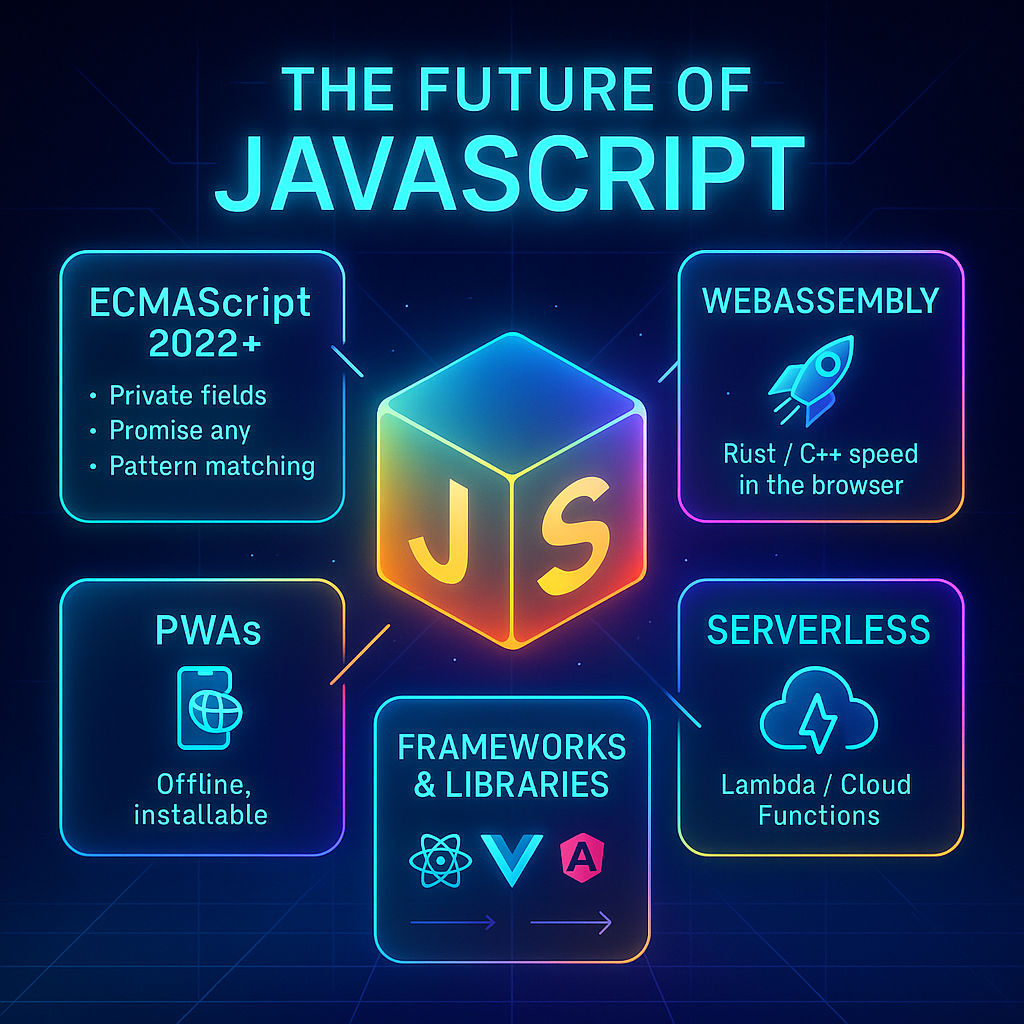JavaScript, the programming language that powers the web, has come a long way since its humble beginnings. From a simple scripting language to a full-fledged programming powerhouse, JavaScript has evolved to become one of the most widely used languages in the world. As we look to the future, it’s exciting to see what lies ahead for JavaScript. In this article, we’ll explore some of the upcoming features and trends that are shaping the future of JavaScript.
Table of Contents
- ECMAScript 2022 and Beyond
- WebAssembly (Wasm)
- Progressive Web Applications (PWAs)
- Frameworks and Libraries
- Serverless Architecture
- Conclusion
1. ECMAScript 2022 and Beyond
ECMAScript, the standardized specification for JavaScript, is constantly evolving to keep up with the demands of modern web development. ECMAScript 2022, scheduled for release later this year, brings several new features and improvements to the language. Some of the notable features include private class fields, logical assignment operators, and the new Promise.any() method.
Looking further ahead, ECMAScript 2023 and beyond promise even more exciting additions. Features like pattern matching, record and tuple types, and enhanced error handling are being considered. These features will enhance the expressiveness and reliability of JavaScript, making it a more robust language for building complex applications.
2. WebAssembly (Wasm)
WebAssembly, often referred to as Wasm, is a binary instruction format that allows developers to run high-performance code on the web. While not exclusive to JavaScript, it has a significant impact on the future of web development. JavaScript can now leverage the power of Wasm by integrating it seamlessly into web applications.
Wasm opens up possibilities for using other programming languages like C++, Rust, and Go to write performance-critical parts of web applications. This will lead to faster and more efficient web experiences, making JavaScript an even more versatile language for building web applications.
3. Progressive Web Applications (PWAs)
Progressive Web Applications (PWAs) have been gaining traction in recent years as they offer a hybrid approach between web and native mobile applications. PWAs use modern web technologies, including JavaScript, to deliver app-like experiences to users across multiple platforms.
JavaScript plays a crucial role in the development of PWAs by enabling features like service workers, offline caching, push notifications, and more. As the demand for PWAs continues to grow, JavaScript developers will need to familiarize themselves with the specific tools and frameworks tailored for PWA development.
4. Frameworks and Libraries
JavaScript has a vibrant ecosystem of frameworks and libraries that power modern web development. React, Vue.js, and Angular are just a few examples of popular JavaScript frameworks that have revolutionized the way we build user interfaces.
Looking ahead, these frameworks will continue to evolve, incorporating new features and optimizations. React, for instance, is working on Concurrent Mode, which enables smoother user interactions and better performance. Similarly, Vue.js is focusing on improved TypeScript integration and enhanced developer experience. JavaScript developers can expect more powerful tools and frameworks that simplify complex tasks and improve productivity.
5. Serverless Architecture
Serverless architecture, also known as Function as a Service (FaaS), has gained significant momentum in recent years. JavaScript plays a crucial role in this trend, as it is often used for writing serverless functions deployed on platforms like AWS Lambda, Azure Functions, and Google Cloud Functions.
Serverless architecture allows developers to build scalable and cost-efficient applications without managing server infrastructure. JavaScript’s lightweight nature and event-driven programming model make it a natural fit for serverless computing. As this trend continues to grow, JavaScript will remain a go-to language for serverless application development.
Conclusion
In conclusion, the future of JavaScript is incredibly promising and dynamic. With advancements in ECMAScript standards, the integration of WebAssembly, the rise of Progressive Web Applications, the continuous evolution of frameworks and libraries, and the growing popularity of serverless architecture, JavaScript remains at the forefront of web development.
JavaScript developers have an exciting road ahead, with new language features, improved performance, and enhanced development capabilities. The language is becoming more powerful, expressive, and versatile, enabling developers to create sophisticated and interactive applications across different platforms. Embracing the future of JavaScript involves staying updated with the latest ECMAScript standards, exploring the potential of WebAssembly to enhance performance, adopting Progressive Web Application techniques for better user experiences, and leveraging evolving frameworks and libraries to streamline development processes. As technology and user demands evolve, JavaScript will continue to play a crucial role in shaping the web development landscape. It will remain a go-to language for building dynamic and responsive applications, whether for front-end interfaces or server-side functionality. With its vast ecosystem and community support, JavaScript offers immense opportunities for developers to innovate and create remarkable web experiences. As the language continues to evolve and adapt, JavaScript developers can look forward to an exciting future filled with possibilities and endless potential.

Leave a Reply